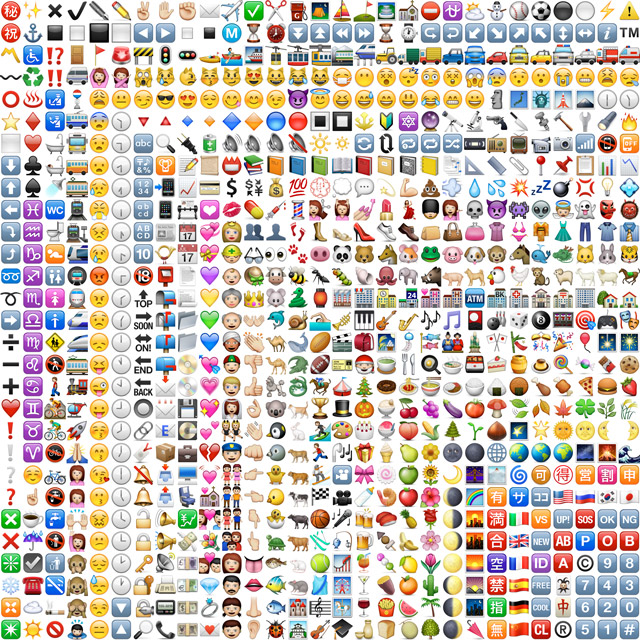 Have you heard of the world’s fastest growing language? It was born just 20 years ago, and already hundreds of millions (possibly billions) of people use it to communicate every day. You’ve probably used it today without even thinking. I’m talking about Emoji.
Have you heard of the world’s fastest growing language? It was born just 20 years ago, and already hundreds of millions (possibly billions) of people use it to communicate every day. You’ve probably used it today without even thinking. I’m talking about Emoji.
These expressive little symbols have slowly seeped into every form of textual communication on the planet. From smiley faces to praying hands to trains, snowmen, hamburgers and cellos — Emoji’s 722 characters capture a huge range of emotion and experience. Not bad for a gimmick designed to appeal to Japanese teenagers in the mid-1990s.
Although they look very similar, Emojis should not be confused with the more general category of graphical emoticons. The latter are also expressive pictographs, but they are invariably locked to a single platform. You cannot send a Skype emoticon to someone on BlackBerry Messenger or Google Hangouts.
But because Emoji is a typeface (such as Arial or Times New Roman) it is entirely platform independent. And so its quirky little characters show up everywhere from Twitter to WhatsApp to e-mail. The trend has already reached its logical conclusion: a copy of Moby Dick, translated into Emojis, has been acquired by America’s Library of Congress. Yes, really.
How did Emoji become a typeface? It had nothing to do with ambitions for global reach or universal communication and everything to do with solving an engineering challenge. In the mid 1990s, the mobile Internet was in its infancy. Even sending a tiny 16×16 icon could take a long time and cost a fortune. And so Shigetaka Kurita, the father of Emoji, had to figure out a better way to send the symbols without clogging up the network.
His solution was brilliant in its simplicity. Instead of sending the actual icons between phones, he mapped the symbols to unused characters in the standard Japanese character set. He then pre-loaded the icons on every phone along with the character map. So what would otherwise be a meaningless placeholder character became a smiley face or a dancing lady.
Kurita could never have guessed the long-term consequences of his clever but specific solution. By creating a typeface, Kurita unintentionally created an open standard. This allowed his Japanese competitors to use the same technology and an arms race of symbolic communication ensued. The number of Emojis ballooned from a few dozen to hundreds, capturing aspects of every part of life including, bizarrely, a symbol for a smiling pile of poo.
By the middle of the 2000s, Emoji had already begun to trickle out into the rest of the world, but when Apple adopted it in 2011 (with the release of iOS 5), it went truly global. Since then, it has swept through the world. It’s rare to find someone with a smartphone (regardless of brand) that doesn’t either use or, at the very least, receive Emojis.
The psychology that drives this kind of thing is well known. Text messaging lacks social cues such as tone of voice and facial expression. Symbols lend emotion to otherwise flat text. The first person to solve this conundrum was Scott Fahlman, a professor of computer science at Carnegie Mellon University. In a famous e-mail in 1982 (yes, 1982), he came up with the first text-based emoticons 🙂 and 🙁 for smiley and sad faces.

His modest proposal created the emoticon, and by extension gave rise to Emojis. In a fit of grumpy purism, Fahlman has since complained that Emojis are “ugly” and lack imagination. The rest of the world’s population respectfully disagrees.
If you need a sign of just how globally significant Emojis have become, look at the campaign to introduce icons for different races. All of the Emojis representing people are currently light skinned. Understandably, this irritates and marginalises the majority of the globe’s population.
After much dithering, the The Unicode Consortium (the standards body in charge of Emojis) has agreed to roll out support for different skin tones by the middle of 2015. These skin tones will be in a spectrum of shades, representing a much wider range of humanity that the current lily white.
The most surprising thing, though, isn’t the technology behind Emoji, or the politics surrounding it. Without a scrap of marketing, activism or legislation, without any fanfare or press, this new language has quietly slid into our everyday lives. And to that I say (smiley face), (thumbs up), (rocket ship).
- Alistair Fairweather is chief technology officer for integrated advertising agency Machine
- This column was first published in the Mail & Guardian Online, the smart news source




